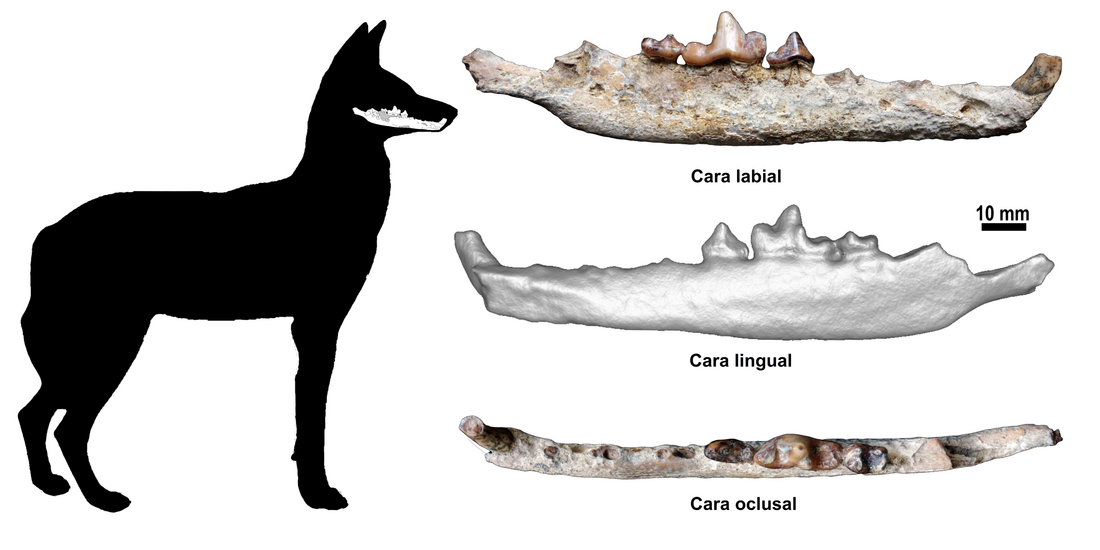Finding of the first and unique fossil of the Ethiopian wolf
The Ethiopian wolf, Canis simensis, is one of the most endangered species of the world. It is a middle size canid, weighing 12-18 kg, that exists only in the highest areas of Ethiopia, more than 3000 meters above sea level. There are only 500 living individuals, of which a mere 200 are reproductive adults.
It has been largely thought that the species arrived to the Ethiopian Highlands less than 100.000 years ago and adapted to this particular environment by becoming a super-specialist in predating on the giant mole-rat (Tachyoryctes microcephalus).
In 2017, a fossil of the right side of a lower jaw was found in the archaeological Acheulian site of Melka Wakena, located on the Southeastern Ethiopian Highlands at an elevation ~2300 m above sea level. The specimen, inventoried as MW5-B208, was identified as belonging to the Ethiopian Wolf and is the only fossil ever found to date. It was recovered from a well-date stratigraphic series, and its placement within this sequence suggests its date to about 1.5 million-years-old. This find provides uncontested evidence for the species’ early presence in Africa.
This paleontological find is the key for modeling the bioclimatic niche of the Ethiopian wolf. Data about the climate and ecology of extant populations of the Ethiopian wolf were applied in an eco-climatic model in order to reconstruct conditions in Ethiopia during successive climatic cycles since the first arrival of the Ethiopian wolf to the African continent, highlighting the species resilience through cycles of favorable and unfavorable conditions and underscoring the necessary conditions for its survival. The model suggests that Canis simensis could have existed only on the Ethiopian Highlands. Populations encountered severe survival challenges in the past, including consecutive drastic contractions of their geographic range during warm periods, which may have resulted in periodic bottlenecks, similar to historical and modern situations. Conversely, both the geographic ranges and population sizes increased during colder periods, reducing the degree of spatial fragmentation and isolation of the populations.
The temporal depth allowed by the discovery of the fossil enable construction of future scenarios for the survival of this endangered species. Projections ranging from most pessimistic to most optimistic future climatic conditions indicate significant reduction of the already-deteriorating territories suitable for the Ethiopian Wolf, increasing the threat to the specie’s future survival. These results highlight the need for scaling-up conservation efforts to safeguarding the remaining fragmented habitats of this ecologically specialized and highly endangered species.
This find is significant also for research on human evolution in Africa. The African Rift Valley has yielded most of the important findings related to early human origins and its associated. The recovery of the Melka Wakena fossil and identifying its long-term endemic existence on the Ethiopian highlands emphasizes the importance of this and other regions outside the Rift in the pursuit of understanding the world of our ancestors, their evolution and their dispersal out of Africa.
The Melka Wakena project is directed by Erella Hovers and Tegenu Gossa, The Hebrew University of Jerusalem, Israel. This study has been coordinated by Bienvenido Martínez-Navarro, from the ICREA, IPHES-CERCA, Universitat Rovira i Virgili, Tarragona, Spain, with collaboration of colleagues from Ethiopia, Italy, Spain and the United States.
Reference
Bienvenido Martínez-Navarro, Tegenu Gossa, Francesco Carotenuto, Saverio Bartolini-Lucenti, Paul Palmqvist, Asfawossen Asrat, Borja Figueirido, Lorenzo Rook, Elizabeth M. Niespolo, Paul R. Renne, Gadi Herzlinger and Erella Hovers, 2023. The earliest Ethiopian wolf: Implications for the species evolution and its future survival. Communications Biology.
This IPHES-CERCA action favors the Sustainable Development Goals (ODS) 15 (Life of Terrestrial Ecosystems)






